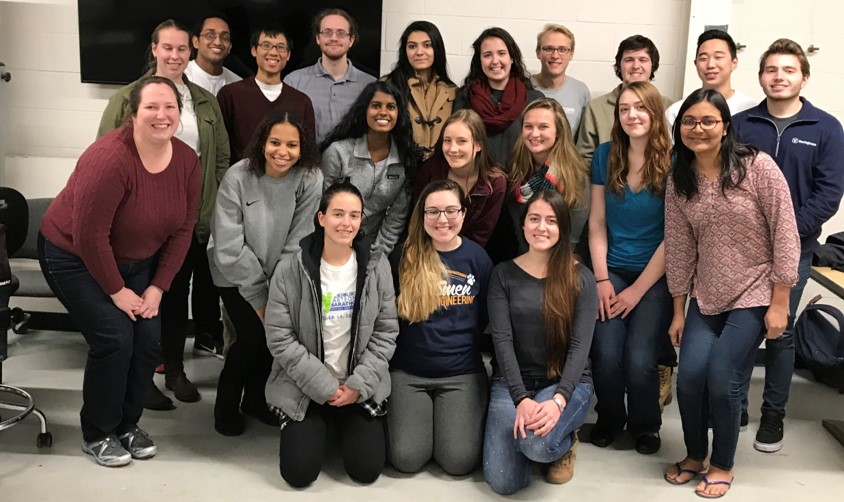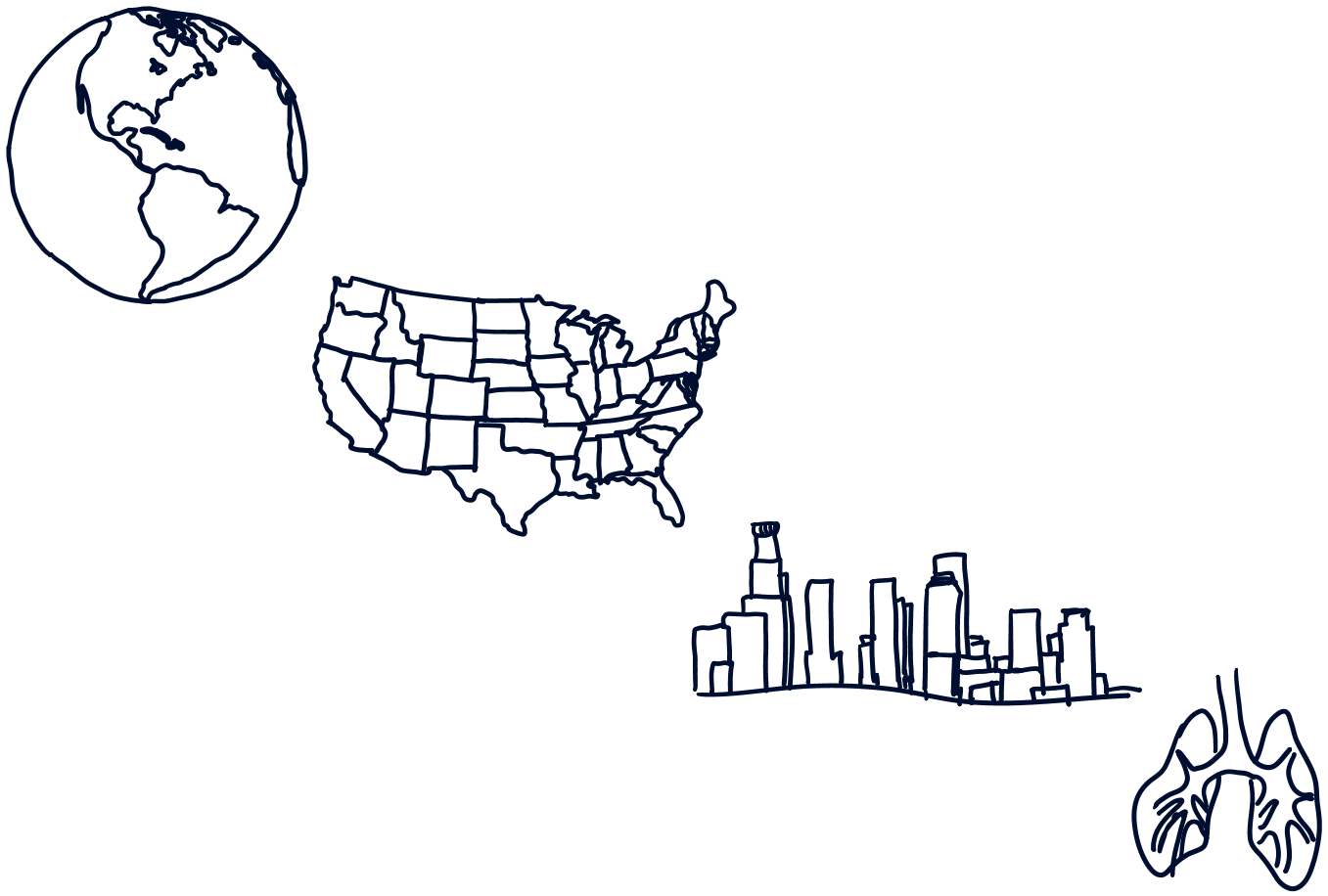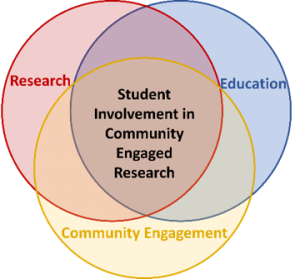

Lab Overview
The Computational Atmospheric Chemistry and Exposure (CACE) Laboratory specializes in applying computational engineering-based approaches to address the impacts of air pollution on human and ecosystem health. We use a combination of chemical transport modeling (CAMx and CMAQ), near source modeling (RLINE and AERMOD), other novel modeling approaches, low cost monitoring, and community partnerships to effectively address a variety of questions. The overarching goal of my laboratory is to bridge the gap between the basic scientific understanding of the transport and transformation of atmospheric pollutants and the tools policy makers and communities use to develop potential air pollution abatement strategies. As much of this research naturally lends itself to community engagement and empowerment, I strive to develop research directions that address community concerns and engage students with the community. The figure to the right shows the overlap between research, education, and community engagement that I envision for my career long-term moving towards a community-based participatory research model.
Engaging Communities to Bridge the Local to Regional Gap in Air Pollution Exposure Assessment. (NSF CAREER #1752231: 6/1/2018 – 5/31/2023: $500,000) My lab is developing the models and datasets necessary to equip communities and students to solve or advocate for scientifically sound solutions to local air pollution concerns while increasing retention and recruitment of underrepresented students in engineering in the process. We are creating a dataset of extensive, detailed, and accessible modeled air pollution concentrations and exposures needed for community planning, advocacy, and empowerment; partnering with neighborhood associations to create a robust local dataset of measured air pollutant concentrations in Hartford; and engaging engineering students in service learning projects using local air pollution assessment projects.
Resolving Source Contributions to Atmospheric Deposition. (NSF Environmental Engineering #1705813: 9/1/2017 – 8/31/2020: $299,990) My lab is estimating the temporal, spatial, and source resolved contributions to atmospheric nitrogen species loadings in watersheds throughout the contiguous United States to inform and improve watershed management using a novel, globally transferrable methodology. We are quantifying the spatially- and temporally-resolved contributions from major source regions and source sectors contributing to the deposition of atmospheric nitrogen species in watersheds in the United States and evaluating the watershed specific impacts from atmospheric deposition attributed to different source regions and sectors.
Source Contributions to Ozone in Connecticut. (CT Department of Energy and Environmental Protection) My lab will identify the major sources which contribute to ozone nonattainment in Connecticut and evaluate measures which could most expeditiously bring Connecticut into attainment with the standards. We will estimate the contributions from individual sources and source regions in the New England and Mid-Atlantic region for both 2016 and 2023 using two different air quality modeling platforms.
Pesticide Drift from Conventional to Organic Farmlands. (UConn CESE Mini-Grants in Support of Environmental Research Programs || UConn Academic Plan Program / Student Engagement in a Living Laboratory for Sustainable Agriculture – PD: Richard Parnas) This project is part of a larger project to create a living laboratory at the UConn Spring Valley Student Farm (SVSF) for students to develop ideas for sustainable energy, water use management, crop nutrient and soil health management, unique living experiences, community outreach, and the social and environmental considerations of our food systems. As part of this project, we have measured and will model the airborne transport and subsequent deposition of fertilizers, pesticides, and herbicides used on adjacent UConn corn and hay fields to the SVSF. This transport of chemicals has the potential to significantly impact nearby agriculture, ecosystems, and communities and has already had an impact on regulatory and legal actions throughout the United States.
Global Particulate Matter Source Apportionment. We are developing and implementing a new global source apportionment tool in the GEOS-Chem global model to provide improved estimates of the contributions from different regions and atmospheric processes to atmospheric gas and particle pollutant concentrations. We are quantifying the contributions from different source regions (e.g. emissions from Central America), megacities (e.g. emissions from Tokyo, Japan), and processes (e.g. specific gas-phase chemical reactions) to atmospheric concentrations. We will expand this work in the future to quantify source contributions to changes in climate forcing and precipitation.
Quantifying the Fraction of Emissions Inhaled from Different Sources. The intake fraction (iF), fraction of emissions that are inhaled, provides a means to determine the relative impact of different emission sources. We used two approaches to quantify the impacts of exposure from pollutant transport in the continental United States. First, we estimated the ground level concentration contributions and intake fraction for different height point source emissions. Next, we used the same metrics to quantify exposure variation with distance from different source regions. This approach allowed us to estimate the total potential impact because we accounted for the transport and transformation of pollutants on regional scales and estimated the intake fraction of both primary and secondary pollutants.
Minor Projects. In addition to the major projects described above, I also have several ongoing, smaller projects led by undergraduate researchers. These projects primarily fall into three categories: (1) projects based on addressing concerns raised by the community, (2) estimates of human exposure and ecosystem impacts based on available datasets, and (3) low-cost air quality monitoring. Recent community-posed projects include estimating the potential air quality benefits of tree plantings in urban areas and the impacts of upcoming renovations of the Hartford Municipal Waste Incinerator. Undergraduate researchers are using existing air pollution estimates to estimate exposure at schools, exposure to cyclists, impacts of heating choices, environment equity, and impacts on crop yields. Additional students are working with low-cost air monitoring technologies to measure near road particulate matter with a UAV, measure the particulate matter levels within the Stamford Transportation Center, and measure ambient air quality impacts of residential heating with wood.
Engineering Education Research. (Campuses for Environmental Stewardship - Campus Compact || UConn Provost’s Teaching Innovation Mini Grant Competition) I have also laid the groundwork for research into many of the innovative teaching approaches have I employed in the classroom. At this point, I have presented on many of these approaches at conferences and have plans to develop full manuscripts in the near future sharing my findings. I have also leveraged my experience in service-learning to increase my participation in workforce development through the Sustainable Community Food Systems program, an intensive minor program requiring internship experience and substantial project work.

Search this site
Contact Information
| Phone: | (860) 486-1715 |
|---|---|
| E-mail: | kristina.wagstrom@uconn.edu |
| Address: | University of Connecticut Chemical and Biomolecular Engineering Attn: Kristina Wagstrom, UTEB 286 191 Auditorium Rd., Unit 3222 Storrs, CT 06269 |